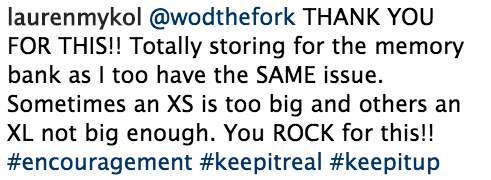Woman Calls out 'B.S.' Clothing Sizes and Their Impact on Body Image
By:
Shopper Katy Hamilton selected two pairs of a size 10-denim jean at her nearby Express store—and was surprised to find that, even though they were the same jeans, the size difference was vast.
This prompted her to post a side-by-side selfie of her fitting room experience and how the variance in clothing sizes can affect the body confidence of women everywhere.
LOL sizing is SUCH bullshit these are both a size 10 short from express in their lowrise leggings. Literally the same store, cut, size, etc. The one was a hair too big & the other didn't even go over my thighs like WHAAAT?! My reason for sharing is...If you ever find yourself in a fitting room ready to bust into tears when something doesn't fit (we've all been there, myself included...millions of times...ask my mom) REMEMBER THIS PIC! There are times I'm a small, times I cant even muscle into a large, times a 10 falls off my hips & times, like this, it doesn't even get past my thighs. Sizing is silly...no one will know if you had to bump up or down because of the cut, style, or likely completely wrong sizing on the store's part. You mean so much more than fitting into the smallest size you can. Our value should never come from a number...on the scale or in our clothes.
Hamilton’s post went viral with almost 10,000 likes and over 200 comments of women sharing the same sentiment.
 Instagram.com - instagram.com
Instagram.com - instagram.com
 Instagram.com - instagram.com
Instagram.com - instagram.com
 Instagram.com - instagram.com
Instagram.com - instagram.com
Following the viral post, Hamilton spoke to TODAY Style. “I think sizing inconsistencies are, unfortunately, really common," she said. "In this case, the frustration was that these jeans weren’t just a little tight or a little loose; the fit was probably a difference of three sizes! At the end of the day, it is what it is, but it's pretty ridiculous and seems like there should be an easy fix.”
Jessica Murphy, co-founder of TrueFit, told Today Style that brands develop sizes based of their customers.
"What's happened over time is that (brands) have evolved their sizing to represent who they believe their core customer is. That's why we have so much inconsistency. If you have a brand catering to a 60-year-old customer, their size medium is going to be representative of their demographic. If you contrast that with a brand serving a tween or teenage customer, their size medium is going to look very different."
Where does sizing come from?
Vox explored the history behind clothing sizes and how they have changed over the last century.
When coming up with sizes, designers, at least initially, "only used white women, even though they took measurements of women of color they did not include them in the study or calculation," Dr. Lynn Boorad told Vox. "The women most likely to turn out for the studies were poor white women, because they would be paid. So, I think the data back then was possibly malnourished women, certainly poor women, and not very diverse group of women. That’s what they started with.”
The industry trend of "vanity sizing" doesn’t help. Brands are lowering sizes on clothing to give women the impression that they are smaller than they actually are.
Hamilton told TODAY Style, just as she mentioned in Instagram post, that she wants everyone to forget numbers and reinforce their self-value. “We shouldn’t be defined by some arbitrary size. I'm a huge proponent of finding the value we place in our lives and ourselves outside of numbers—calories, followers, salaries, weight or clothing sizes—and wanted to spread that message to others."
Boorady agreed, telling Vox: “It’s not you, it’s the industry. It’s not women’s bodies, we’re fine the way we are, they are just random numbers. They don’t mean anything. And if you don’t like the size, just cut it out of your clothes.”
